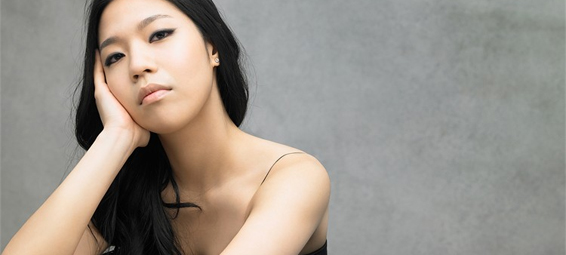It has been said, and with good reason, that real music criticism does not exist. What you are reading now is a review—an evaluation, if you wish. Real criticism of music, in terms of the speculative investigation and analysis that characterizes literary criticism, is virtually nonexistent.
However, in her recital Tuesday night on the Cliburn Foundation’s concert series at Bass Performance Hall inFort Worth, pianist Joyce Yang created a program that did, indeed, invite the listener to hear and respond to old music in new ways, just as the skilled literary critic challenges the reader to experience iconic literature in a new light. Although each segment of the program was amazing and engaging in itself, Yang’s beautifully crafted sequence—which she, borrowing a term from the visual arts, aptly terms “collage”—produced an enriching web of meanings and interrelationships among the five composers whose works she explored.
In the opening work on the program, J.S. Bach’s Chromatic Fantasy and Fugue, Yang once again demonstrated her ability to create fluid passage-work, as well as her mastery of discreet use of the damper pedal in the music of Bach; the closing moments of the Fantasy were beautifully desolate.
But it was in leaping over a century and a half to Debussy’s boldly evocative Estampes that Yang began to make her larger point. Set off against the rich counterpoint of the Bach, the glorious tensions of Debussy’s deliberately remote portrayal of Chinese, Spanish, and French landscapes, came into vivid relief. Yang then charged forward nearly yet another century, to Lowell Liebermann’s Gargoyles, a blisteringly difficult piece applying romantic and early modern pianistic virtuosity (echoes of Liszt, Balakirev, and Prokofiev abound) with twentieth-century aesthetic.
After intermission, Yang turned to Schubert’s serene Impromptu in G-flat and Schumann’s Fantasiestucke. Here, she began, both in her performance and in her spoken commentary, to draw toward a conclusion familiar to literary critics (and, within this context, totally convincing) of the presence of the dream and dream imagery in this music.
Yang even managed to fold what might be viewed, at first glance, as a light-hearted encore into her vision. In Yang’s performance, Earl Wild’s flashy riff on Gershwin’s “The Man I Love” became a cyclone of desire, if not on the same level of profundity with the music of Bach, Debussy, Schubert, and Schumann, at least worthy to share the stage with those geniuses. And, once again, Yang proved herself to be one of the most versatile and thoughtful of the rising pianists of our time.
Photo by Oh Seuk Hoon via





